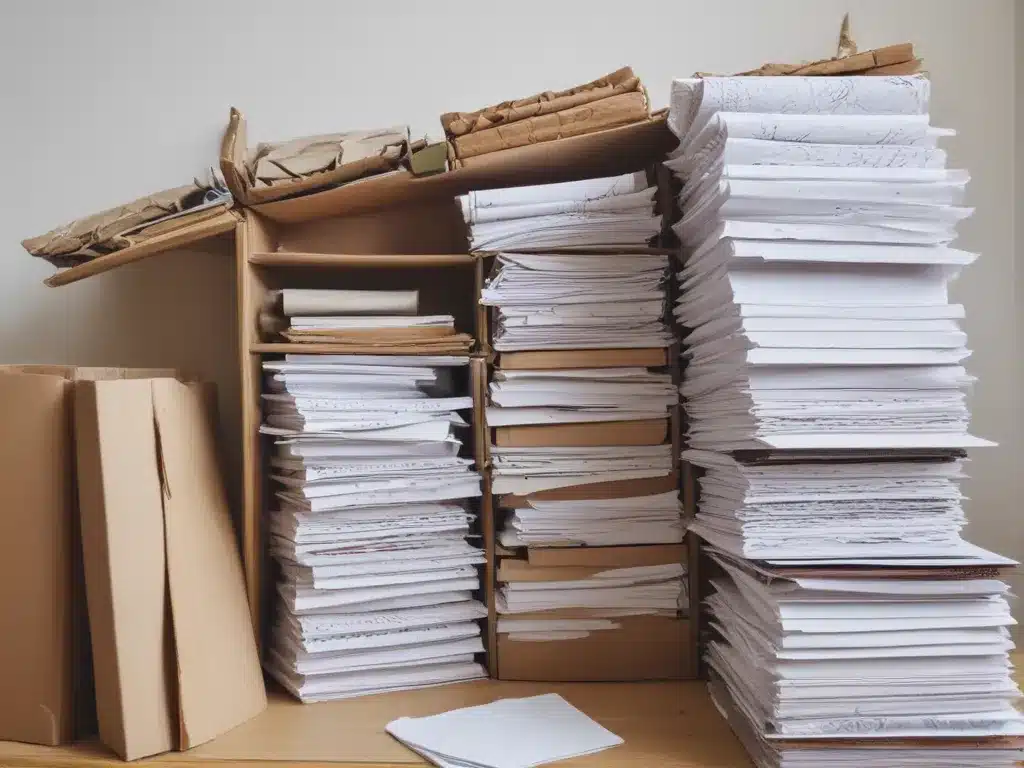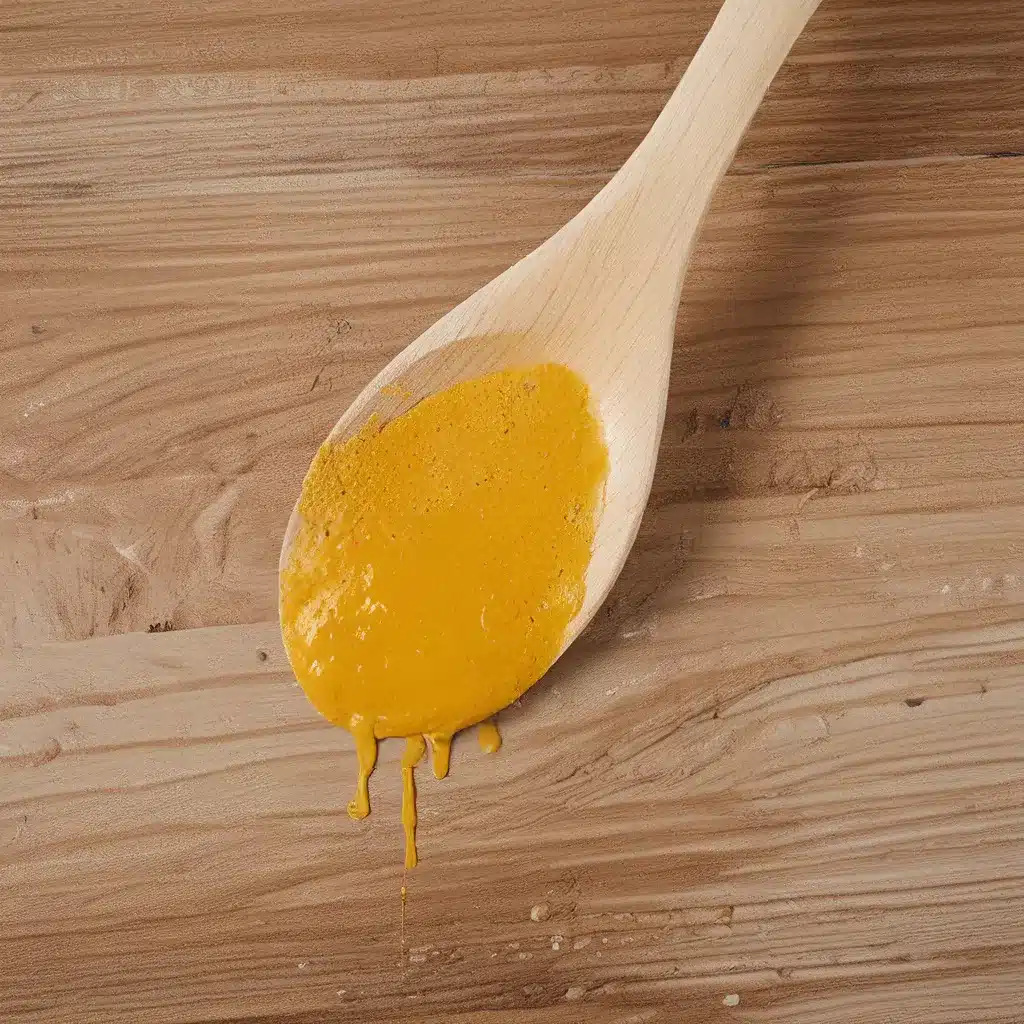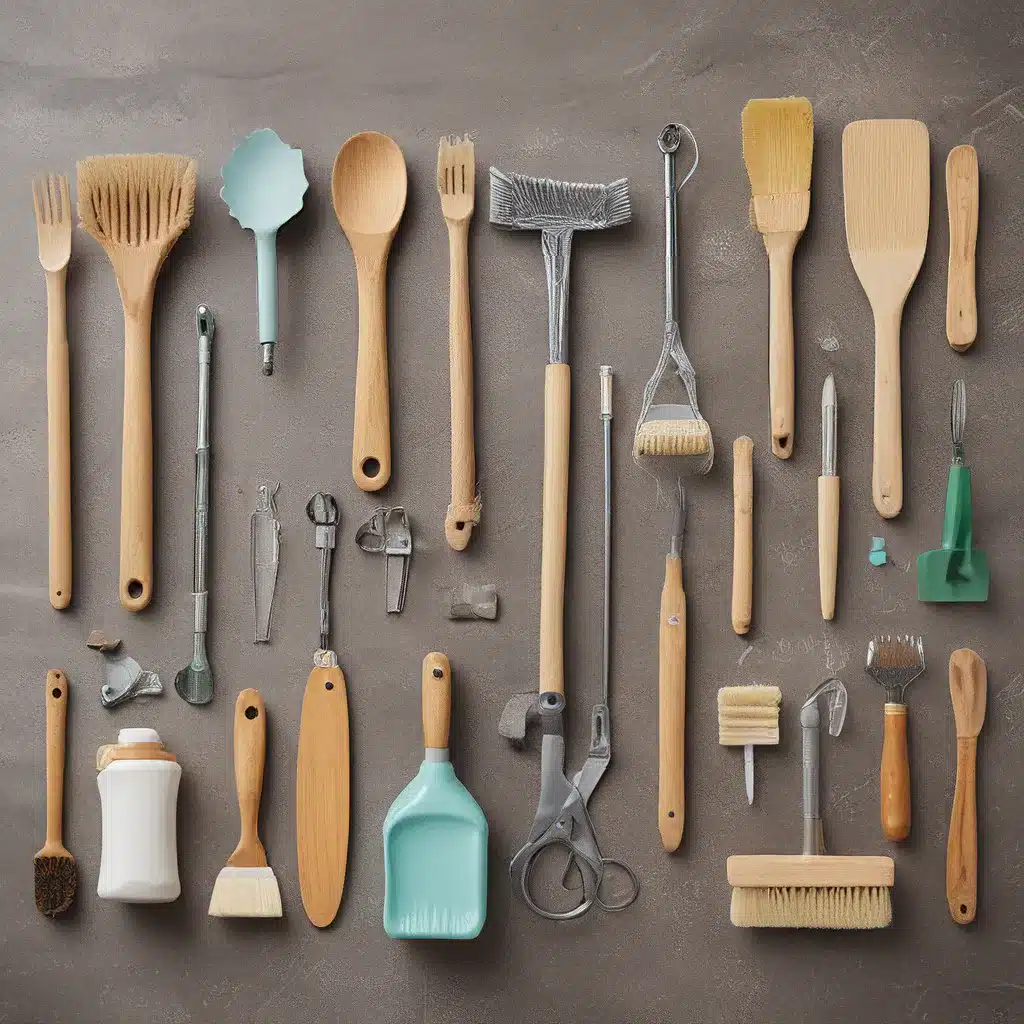Embrace the Power of Decluttering
I have always been fascinated by the transformative power of decluttering. The ability to simplify and streamline our surroundings can have a profound impact on our mental well-being, productivity, and overall quality of life. As the founder of AdamCleaning.uk, I have witnessed firsthand the profound effects that a decluttered environment can have on individuals and businesses alike.
One of the most persistent and challenging forms of clutter that we often struggle with is paper clutter. The sheer volume of documents, receipts, bills, and miscellaneous papers that can accumulate in our homes and offices can be overwhelming, leading to feelings of stress, anxiety, and a sense of being constantly overwhelmed.
In this in-depth article, I will share my expertise and practical strategies to help you conquer paper clutter and achieve a clear mind. Through a step-by-step process, we will explore the root causes of paper clutter, the benefits of decluttering, and the most effective techniques to maintain a clutter-free environment.
Understanding the Impact of Paper Clutter
The presence of paper clutter can have a significant impact on our mental and physical well-being. I have observed that individuals who struggle with paper clutter often experience a range of negative consequences, including:
-
Increased Stress and Anxiety: The sight of piles of papers, the fear of losing important documents, and the constant search for information can contribute to heightened levels of stress and anxiety, making it difficult to focus and be productive.
-
Decreased Productivity: The time and energy spent searching for documents, managing the clutter, and feeling overwhelmed can result in a significant loss of productivity, both at home and in the workplace.
-
Reduced Decision-Making Abilities: When our environment is cluttered, our cognitive abilities can become impaired, making it harder to make clear and informed decisions.
-
Physical Health Concerns: Paper clutter can also lead to physical health issues, such as allergies, respiratory problems, and increased risk of accidents or injuries due to tripping hazards.
Recognizing the profound impact of paper clutter is the first step towards taking control and creating a more organized, efficient, and stress-free environment.
Identifying the Root Causes of Paper Clutter
Before we dive into the strategies for decluttering, it is essential to understand the root causes of paper clutter. By identifying the underlying factors, we can develop a more targeted and effective approach to address the problem. Some of the common causes of paper clutter include:
-
Lack of a Consistent Filing System: Many individuals struggle with paper clutter because they lack a reliable and consistent filing system. Without a clear organizational structure, important documents can easily get lost or misplaced.
-
Digital Overload: In the digital age, we are constantly bombarded with electronic documents, emails, and online statements. The inability to effectively manage and organize this digital information can contribute to the accumulation of physical paper clutter.
-
Emotional Attachment: Some people may hold onto certain papers, such as old letters, cards, or sentimental documents, due to an emotional attachment or a fear of letting go.
-
Procrastination and Indecision: Delaying the decision-making process regarding which documents to keep or discard can lead to a gradual buildup of paper clutter over time.
-
Lack of Designated Storage Solutions: Insufficient or poorly designed storage solutions, such as cluttered desks or overflowing file cabinets, can exacerbate the problem of paper clutter.
Understanding these root causes will enable us to develop a more holistic and effective approach to decluttering and maintaining a clutter-free environment.
Embracing the Benefits of Decluttering
Decluttering paper clutter can unlock a wide range of benefits, both tangible and intangible. By embracing the power of decluttering, you can experience:
-
Improved Mental Well-being: A decluttered and organized environment can significantly reduce stress and anxiety, leading to a more calming and focused mindset.
-
Enhanced Productivity: With a clear and organized workspace, you can easily find the information you need, reduce the time spent searching for documents, and focus more on the tasks at hand.
-
Increased Clarity and Decision-Making: A decluttered environment can sharpen your cognitive abilities, improve your decision-making skills, and help you think more clearly.
-
Reduced Physical Health Risks: Eliminating paper clutter can minimize the risk of allergies, respiratory problems, and accidents or injuries caused by tripping hazards.
-
Elevated Sense of Control: Achieving a clutter-free environment can instill a profound sense of control and mastery over your surroundings, leading to a greater sense of well-being and satisfaction.
-
Increased Efficiency and Savings: Decluttering can help you identify and discard unnecessary documents, leading to cost savings and more efficient use of storage space.
Embracing the transformative power of decluttering can have a lasting impact on your personal and professional life, empowering you to live and work with greater clarity, focus, and well-being.
Developing a Decluttering Strategy
Embarking on the journey of paper decluttering can be daunting, but with a well-structured plan, you can tackle the challenge head-on and achieve lasting results. Here is a step-by-step guide to help you develop an effective decluttering strategy:
Step 1: Assess and Categorize Your Paper Clutter
The first step is to take a comprehensive inventory of your paper clutter. Gather all the documents, files, and papers scattered throughout your home or office and sort them into manageable categories, such as:
- Financial Documents: Bank statements, bills, receipts, tax records, etc.
- Personal Documents: Identification cards, medical records, insurance policies, etc.
- Sentimental Papers: Old letters, cards, photographs, children’s artwork, etc.
- Work-related Documents: Contracts, proposals, client files, etc.
- Miscellaneous Papers: Brochures, magazines, newsletters, etc.
This categorization will help you understand the nature and scope of your paper clutter, allowing you to develop a more targeted decluttering approach.
Step 2: Establish a Filing System
Once you have a clear understanding of your paper clutter, the next step is to establish a reliable and consistent filing system. This can involve creating physical folders or digital document storage solutions, such as cloud-based storage or dedicated document management software.
When setting up your filing system, consider the following best practices:
- Adopt a Logical Organizational Structure: Group similar documents together and use clear, descriptive labels to make retrieval easy.
- Implement a Retention Policy: Determine which documents need to be kept and for how long, and which can be safely discarded.
- Incorporate Digital Solutions: Explore options to digitize important documents, reducing the amount of physical paper clutter.
- Maintain Regular Upkeep: Allocate time each week or month to review, update, and maintain your filing system.
By creating a well-designed filing system, you can significantly reduce the burden of paper clutter and establish a more organized and efficient environment.
Step 3: Declutter and Purge
With your filing system in place, it’s time to tackle the decluttering process. This step involves carefully reviewing each document, making decisions about what to keep and what to discard, and properly disposing of the unwanted items.
Here are some tips to guide you through the decluttering process:
- Establish Clear Criteria: Develop a set of criteria to help you decide what to keep and what to discard, such as relevance, legal requirements, and sentimental value.
- Digitize Whenever Possible: Scan or photograph important documents and store them digitally, reducing the need for physical storage.
- Shred Sensitive Documents: Ensure the proper disposal of any confidential or sensitive documents by using a high-quality shredder.
- Donate or Recycle: For non-sensitive documents that you no longer need, consider donating or recycling them to reduce waste.
- Maintain a Decluttering Mindset: Approach the process with a mindset of letting go, focusing on what you truly need rather than what you might need in the future.
By carefully and systematically decluttering your paper clutter, you can create a more organized and stress-free environment.
Step 4: Maintain a Clutter-Free Environment
Decluttering is not a one-time event; it requires ongoing effort and vigilance to maintain a clutter-free environment. Implement the following strategies to help you sustain your decluttered lifestyle:
- Adopt a “One-in, One-out” Policy: Whenever you bring a new document into your home or office, make sure to discard or digitize an existing one.
- Schedule Regular Decluttering Sessions: Set aside dedicated time each week or month to review your filing system, purge unnecessary documents, and maintain your organized environment.
- Implement Digital Workflows: Leverage technology to minimize the influx of physical paper, such as opting for electronic bills, statements, and document management solutions.
- Involve Your Household or Team: Enlist the support of your family members or colleagues to maintain a shared commitment to a clutter-free environment.
By embracing these ongoing maintenance strategies, you can ensure that your newly decluttered space remains organized and free from the burden of paper clutter.
Overcoming Emotional Attachments and Sentimental Papers
One of the most challenging aspects of paper decluttering can be letting go of sentimental documents, such as old letters, cards, and photographs. These items often hold deep emotional significance, and the thought of discarding them can be overwhelming.
To navigate this emotional hurdle, consider the following strategies:
-
Digitize and Organize Sentimental Papers: Scan or photograph these documents and store them digitally, allowing you to preserve the memories while reducing the physical clutter.
-
Curate and Display Cherished Items: Carefully select the most meaningful sentimental papers and display them in a dedicated photo album or frame, creating a visual reminder of your memories.
-
Share and Distribute Sentimental Items: If possible, consider sharing or distributing sentimental papers with family members or friends who may also find value in them.
-
Practice Gratitude and Letting Go: Acknowledge the emotional significance of these items, express gratitude for the memories they represent, and consciously let go of the physical manifestation to create space for the future.
-
Seek Support and Guidance: If you’re struggling to part with sentimental papers, consider enlisting the help of a professional organizer or a trusted friend or family member who can provide an objective perspective and emotional support.
By addressing the emotional attachments to sentimental papers, you can strike a balance between preserving cherished memories and achieving a decluttered, organized environment.
Tackling Digital Paper Clutter
In the digital age, paper clutter is not limited to physical documents; it can also manifest in the form of electronic files and digital information. Addressing digital paper clutter is just as crucial as managing physical clutter, as it can contribute to feelings of overwhelm and reduced productivity.
Here are some strategies to help you tackle digital paper clutter:
-
Establish a Digital Filing System: Just as you created a physical filing system, develop a consistent and logical structure for your electronic documents, using clear folder names and file naming conventions.
-
Implement a Cloud-based Storage Solution: Utilize cloud-based storage platforms, such as Google Drive or Dropbox, to centralize your digital documents and ensure easy access from any device.
-
Regularly Purge and Organize: Dedicate time each week or month to review your digital files, delete unnecessary documents, and reorganize your digital filing system.
-
Leverage Search and Indexing Tools: Utilize the search and indexing capabilities of your cloud storage platform or document management software to quickly locate specific files and information.
-
Automate Document Handling: Explore options to automate the processing of digital documents, such as setting up rules to automatically file or archive certain types of files.
-
Minimize Email Clutter: Develop effective email management strategies, such as creating folders, using filters, and regularly archiving or deleting emails you no longer need.
By addressing both physical and digital paper clutter, you can achieve a comprehensive decluttering solution that enhances your overall productivity and well-being.
Embracing Minimalism and Decluttering as a Lifestyle
As you embark on your paper decluttering journey, it’s essential to recognize that this process is not a one-time event but rather a lifestyle choice. Embracing minimalism and decluttering as an ongoing practice can lead to profound and lasting benefits.
-
Adopt a Minimalist Mindset: Cultivate a mindset that prioritizes simplicity, intentionality, and the cultivation of a meaningful, clutter-free environment. Regularly evaluate the role of physical possessions and digital information in your life, and let go of what no longer serves you.
-
Develop Decluttering Habits: Incorporate regular decluttering routines into your daily or weekly schedule, ensuring that you maintain a clutter-free space. This could involve a dedicated “paperwork hour” or a monthly “decluttering day.”
-
Seek Inspiration and Support: Surround yourself with resources, communities, and role models that inspire and encourage your decluttering journey. Follow minimalist and organizing influencers, join online communities, or connect with professional organizers for guidance and accountability.
-
Celebrate Small Victories: Recognize and celebrate the small wins along the way, such as completing a decluttering session or finally tackling that dreaded file cabinet. These milestones will reinforce your progress and motivate you to continue your decluttering efforts.
-
Extend the Decluttering Mindset: Once you’ve experienced the transformative power of decluttering paper clutter, consider applying the same principles to other areas of your life, such as your digital environment, wardrobe, or even your schedule.
By embracing decluttering as a lifestyle choice, you can create a lasting, sustainable, and enriching environment that supports your overall well-being and productivity.
Conclusion: Reclaim Your Space, Reclaim Your Mind
In conclusion, the journey of decluttering paper clutter is not merely about organizing physical documents; it is a powerful tool for reclaiming your mental and emotional space. By addressing the root causes of paper clutter, establishing effective filing systems, and maintaining a decluttered environment, you can unlock a world of benefits, including reduced stress, increased productivity, and a greater sense of control over your life.
Remember, the process of decluttering is not a one-time event but a continuous journey of self-discovery and growth. Embrace the minimalist mindset, develop consistent decluttering habits, and surround yourself with the support and inspiration needed to sustain your progress.
As the founder of AdamCleaning.uk, I have witnessed the profound impact that decluttering can have on individuals and businesses. If you’re ready to take the next step and reclaim your space and your mind, I encourage you to explore our professional organization and decluttering services. Together, we can help you achieve the clarity, focus, and well-being you deserve.
Start your decluttering journey today and unlock the transformative power of a clutter-free environment. Your mind, your productivity, and your overall well-being will thank you.







